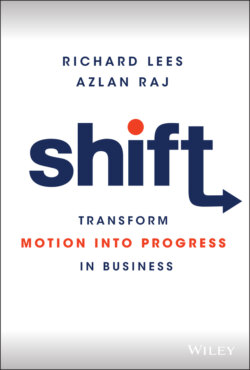Читать книгу Shift - Richard Lees - Страница 19
The Bandersnatch process
ОглавлениеIn business, we have to pivot and change direction sometimes and it's important to remember that the destination we're striving for could also change depending on the route we follow. We also have to recognise that we are never going to reach that destination because that implies an end point. In business, there is no end, merely a constant evolution and adaptation to stay ahead of the competition. Just look at 3M.
The interactive film Bandersnatch, which was produced as part of the Black Mirror series for Netflix, is a simplified example of this process at work. As the viewer, you chose the direction the storyline took at various points throughout the film. In taking certain decisions around the plot, you influenced the ending that you saw. Unlike the world of business, Bandersnatch does of course have an end.
However, it illustrates the point about choosing your direction of travel well. Much like in real life, in Bandersnatch you don't know what ending you're heading towards when you start watching the film. Each decision you take for the main character leads you along a specific story arc. You're essentially opening a door and stepping through it without knowing what's on the other side, even if you might be able to predict what you expect to see.
Another key difference between Bandersnatch and business is that in Bandersnatch you can never go back. Once you take a decision about your direction of travel you are committed to that trajectory. In business, this might be true in some cases, but not in others. Often it will be possible to step back through a metaphorical door.
What we have to recognise in a business context is which doors we can leave open to step back through if we need to, and which ones close behind us, leaving us to navigate forward from that point. As a business, it's vital to make that distinction because if you're stepping through a door that will close behind you, you need to be confident of your next steps from there.
How can you tell if the door you're about to step through will stay ajar or close behind you? There are a few factors that will play a role here. The first is the speed at which you're travelling through that door, because if you race through really quickly, by the time you realise you want to go back, you might be too far from the door. The second is measurement, which we discuss in greater detail in Chapter 2, but fundamentally if you're measuring the right things you will be in a position to retrospectively change the elements that need changing.
Each business will be different and therefore whether it is able to go back through a door will vary. However, all leaders should be challenging themselves on these decisions. As a leader, what you have to work out is whether getting a particular decision wrong is reversible. If the answer to that question is “no”, you have to take time to make that decision.
If the decision won't kill your business, you have to consider what the cost will be for you to step back through that door and course correct. The deciding factor should be whether the opportunity outweighs the risk of making the decision quickly.
